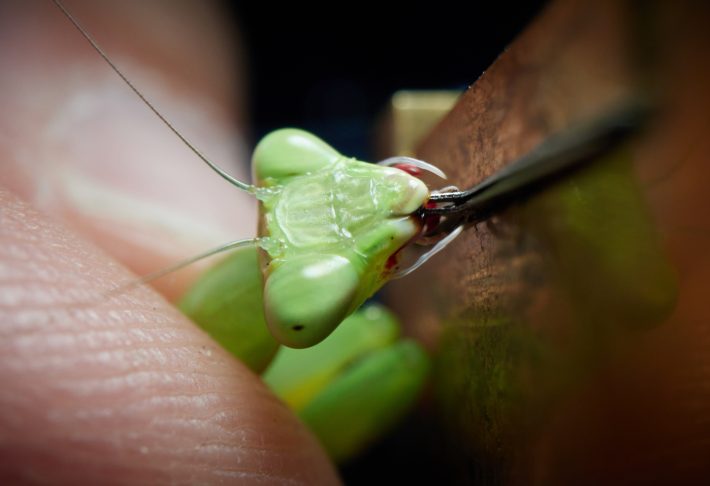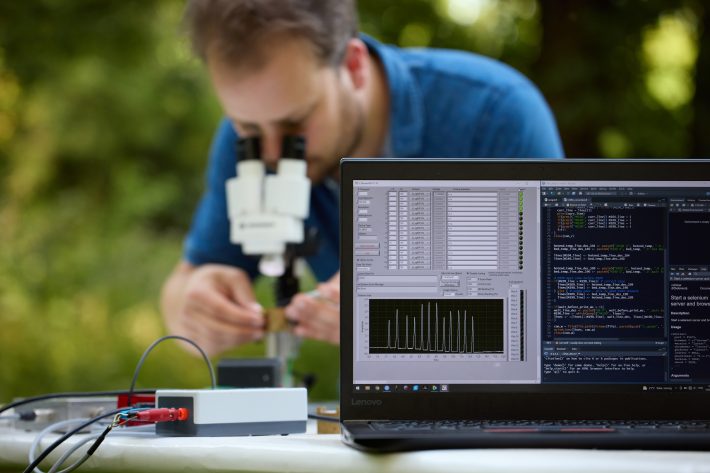University of Bonn press release.
Scientists at the University of Bonn present a sensor system that can measure the bite force of insects.

How hard can insects bite? Having a strong chewing apparatus makes it easier to crush harder food and to succeed in fights with enemies. Biologists at the University of Bonn now present a mobile system (forceX) for measuring the bite forces of small animals, along with the software forceR to evaluate the data. This allows researchers to understand how bite forces evolved. The final version is now published in the journal Methods in Ecology and Evolution thanks to funding by the European Research Council and the German Research Foundation.
The praying mantis wriggles a little in the scientist's hand. When the insect approaches the sensor, it defends itself by biting down on the two metal plates that transfer the pressure to a piezo crystal. The crystal generates a load-dependent voltage that is transmitted to a laptop via an amplifier. Curves appear on the screen, some of which rise steeply and shakily reach a plateau before dropping back to zero. Sometimes the ascent and descent are flatter – depending on how fast the insect approaches maximum force when biting.
Hardly any data on bite force
"There is hardly any data available on how hard insects can bite," says Peter T. Rühr, a doctoral student at the Institute of Evolutionary Biology and Ecology at the University of Bonn. With their sensor system "forceX", the researchers want to investigate how the mandibles, musculature and head shape of insects have evolved to meet the challenges of their respective environments. "It may not always be advantageous to be able to bite hard, because maintaining the ability to do so demands higher energetic costs" Rühr says. The bite force may depend, for example, on what food an insect feeds on or whether it needs the mandibles to defend itself.
"Maintaining the ability to bite down hard demands higher energetic costs"
The team led by Prof. Dr. Alexander Blanke, who has secured a Starting Grant from the European Research Council (ERC), further developed existing systems for measuring bite forces.
The researchers at the University of Bonn, used a stereo microscope, akin to a strong magnifying glass, to detect whether the mandibles of the investigated insect are in contact with the metal plates of the sensor at the correct location. The lower plate is immobile, while the upper one transmits the force to the sensor via a rocker.
Suitable for studying the bite forces of many different small animals
"Depending on the size and opening angle of the mandibles, we use differently sized, interchangeable bite plates," says Rühr, explaining the advancements. "This allows the sensor to be adjusted over a relatively wide range to meet the particular requirements of the animals." The complete system is battery-powered and can therefore be used for mobile measurements – even in the "wild".

For stinging insects, the researchers use a 'holder' made of plastic. The animals disappear completely in the vial, with only its head and mouthparts protruding from a small hole in the front. Rühr: "This allows us to better position the insects without having to hold them in our hands." Usually, the animals do not need much persuasion before they bite. They feel uncomfortable in an unfamiliar environment and fight back with their defensive bites. If this instinctive behavior fails to materialize, the researchers stroke the insect heads with a delicate brush - which prompts the insects to close their jaws.
Highly accurate measurements for Bite force
For publication in Methods in Ecology and Evolution, the researchers determined the accuracy of the system: They did this by attaching different weights, ranging from one gram to almost one kilogram, to the movable metal plate. A total of 1,600 repetitions shows that the deviation between measurements is a maximum of 2.2 percent. "That is very accurate," says Rühr. The system can also be used to measure the force of scorpion or crab claws, for example.
Rühr and Blanke built the system during their time at the University of Cologne, in part with the local precision engineering workshop. At the University of Bonn, they further optimized it and performed the accuracy measurements. The manuscript also describes the new "forceR" software, with which the bite force values, and shapes of the bite curves, can be evaluated and compared. The researchers do not want to bring the bite force sensor system to market. "Rather, the results presented in 'Methods in Ecology and Evolution' provide the basis for replicates," Rühr says. Essential parts of the sensor can even be reproduced using a 3D printer.
You can read the full article here:
https://besjournals.onlinelibrary.wiley.com/doi/abs/10.1111/2041-210X.13909






